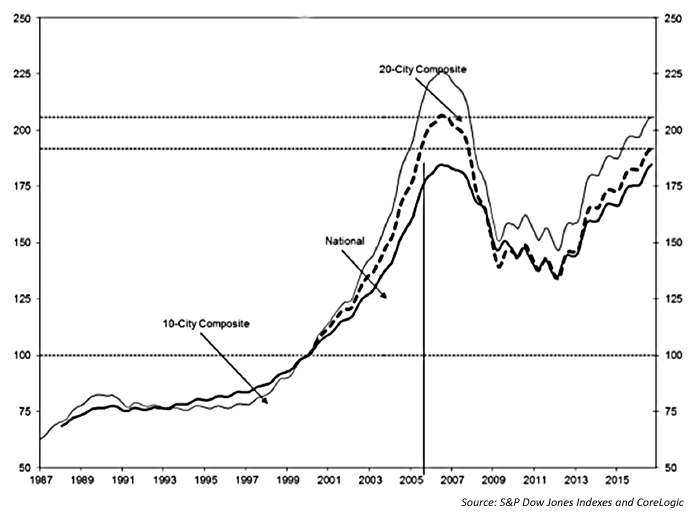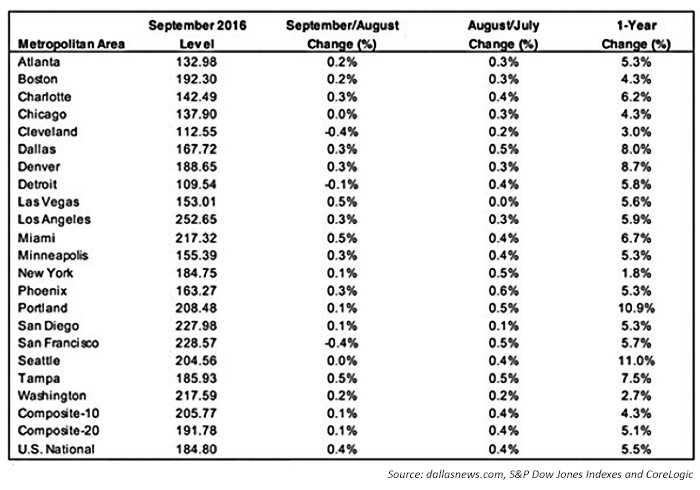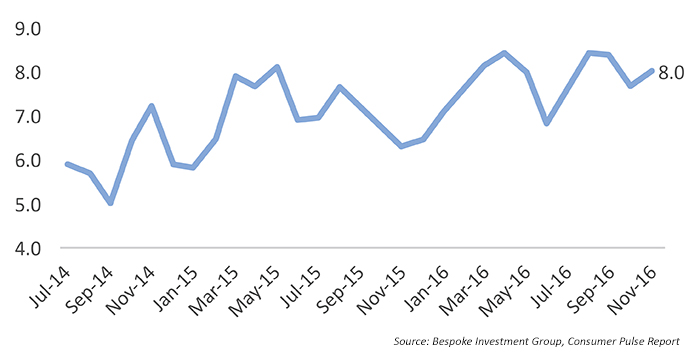
According to a press release from S&P CoreLogic Case-Shiller Indexes on November 29, “the U.S. National Home Price NSA Index, covering all nine U.S. census divisions, surpassed the peak set in July 2006 as the housing boom topped out. The national index reported a 5.5% annual gain in September, up from 5.1% last month.”
As can be seen in the following figure and table, average national home prices have rebounded a fairly remarkable 37.9% from the 2012 trough. According to Frank Nothaft, chief economist at CoreLogic, “Home equity wealth has more than doubled during that [five-year] period, rising from $6.1 trillion to $12.7 trillion.”
FIGURE 1: S&P CORELOGIC CASE-SHILLER INDEXES

TABLE 1: RECENT BOOM-BUST PERIODS FOR 3 CASE-SHILLER INDEXES

While the home price gains for all three Case-Shiller indexes have been impressive, the rebound in housing values has not been consistent from market to market. Detroit and Cleveland remain distant laggards on an index basis compared to major real estate markets in California, Miami, and the Pacific Northwest. Less than half of the 20 U.S. housing markets the Case-Shiller Index tracks are at record average price levels.
Within all markets, there are also major discrepancies between the types of homes that have been showing the greatest price appreciation. The Dallas News recently quoted this observation from Trulia economist Ralph McLaughlin:
“The U.S. housing market recovery has been both limited and uneven. … Just seven metros—Dallas, Fort Worth, Houston, Denver, Nashville, Pittsburgh, Tulsa, and San Francisco—have seen prices of starter homes, trade-up homes, and premium homes surpass their pre-recession peaks. … It’s good news for homeowners who are no longer underwater, but not-so-great news for homebuyers who have seen prices outpace incomes for most of the housing market recovery.”
TABLE 2: HOME PRICE INDEXES FOR MAJOR MARKETS AND YEAR-OVER-YEAR CHANGE

The question of the day is what the recent move higher in interest rates will mean for the national and local housing markets—and whether the recent housing price appreciation reflects in part buyers rushing in to beat anticipated late-2016 and 2017 mortgage rate increases. There have been some very volatile post-election trends in mortgage applications, with applications falling 6% in the week immediately following the election and then jumping 19% the following week.
While conditions vary tremendously market to market, the pre-election (October) expectations of realtors for single-family home sales over the next six months was “strong,” according to the REALTORS Confidence Index published by the National Association of Realtors.
No doubt, recent gains in the stock market and consumer confidence measures, combined with more job creation and slowly increasing wages, has added some tailwinds to expectations for home sales and housing prices. The Bespoke Consumer Pulse Report shows home-buying intentions are trending higher, though it remains unclear what the longer-term impact of an uncertain interest-rate environment will be.
FIGURE 2: LIKELY OR VERY LIKELY TO BUY HOME IN THE NEXT YEAR (%)

